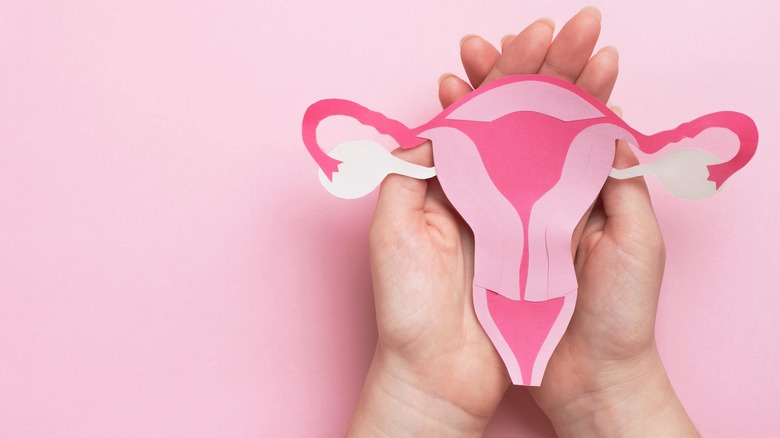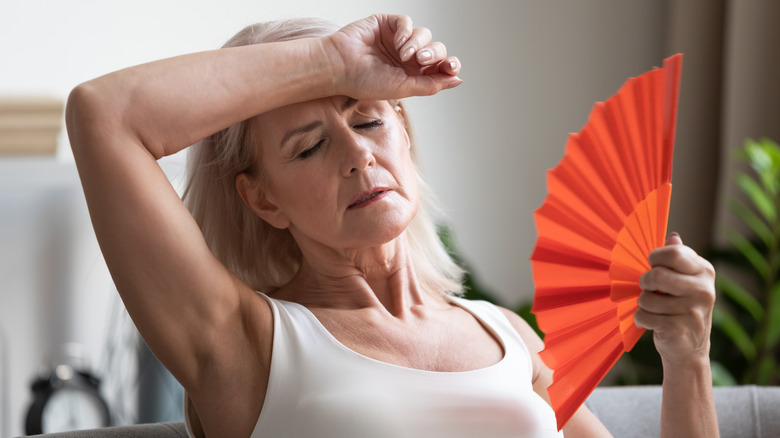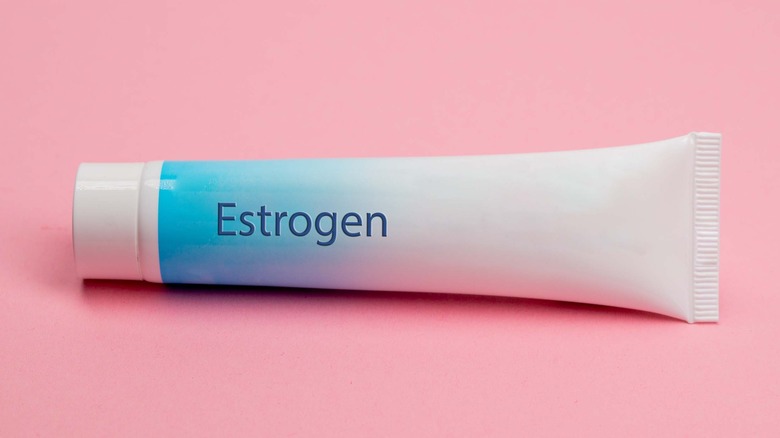What Happens To Your Body When You Take Estrogen?
Estrogen has several effects on the body, and there are various reasons individuals take estrogen as a medication.
Johns Hopkins Medicine explains that estrogen is a hormone that primarily affects sexual and reproductive health in females. Female ovaries produce the most estrogen. However, fat cells and adrenal glands (small glands above your kidneys that produce other hormones, such as cortisol) can also produce small amounts of estrogen.
Besides affecting female reproductive health, Johns Hopkins described estrogen's role in other bodily systems. For example, estrogen affects multiple areas in the body, including the urinary tract, heart and blood vessels, bones, breasts, skin, hair, and mucous membranes (these are the moist inner lining of some body parts, such as the inside of your nose and mouth), pelvic muscles, and brain.
Additionally, per Johns Hopkins Medicine, estrogen is the hormone responsible for the development of many secondary sexual characteristics, such as pubic hair and armpit hair.
Why individuals take estrogen
There are numerous reasons people are prescribed estrogen as a medication. The most common reason for estrogen medication, per MedlinePlus, is to relieve the (often uncomfortable) symptoms of menopause. Taking estrogen can help reduce and prevent hot flashes. Treatment can also relieve vaginal dryness and difficulty with urination that may come with menopause.
For people with a uterus, estrogen is often given with progesterone (another female sex hormone). Combining estrogen with progesterone reduces the risk of uterine cancer with estrogen supplementation. MedlinePlus explains that estrogen is also combined with progesterone in combined oral contraceptive birth control pills. When used in birth control, estrogen is often combined with progesterone (also a sex hormone). For example, to prevent pregnancy, estrogen and progesterone help prevent ovulation (when an egg is released from the ovary). These hormones also change the lining of the uterus and affect the composition of cervical mucus, making it more challenging for sperm to survive and fertilize an egg.
Besides preventing pregnancy, combined oral contraceptives can help with other health conditions too. For example, they are sometimes prescribed to help prevent acne outbreaks due to their effect on the skin (per MedlinePlus). Additionally, since they are female sex hormones, combined oral contraceptives can help treat heavy, or irregular periods, and can also be used in the treatment of endometriosis (an often painful condition, when the uterine lining grows outside the uterus).
Estrogen and transgender care
Feminizing hormone therapy is another reason individuals take estrogen. The University of California, San Francisco (UCSF) Transgender Care provides an overview of the role of estrogen. As estrogen is a primary female sex hormone, many of the changes estrogen therapy has on the body in feminizing hormone therapy involve the development of female sex characteristics. However, UCSF Transgender Care emphasizes that taking higher doses of estrogen does not lead to feminizing changes happening faster. Instead, it could lead to negative health effects. Some complications associated with feminizing hormone therapy include blood clots, high blood pressure, and stroke (via Mayo Clinic).
Once beginning estrogen therapy, an individual may experience numerous physical changes. These include changes to a person's skin, which may become drier and thinner. How an individual's sweat and urine smells may change, and the individual may sweat less. Additionally, small breast buds may develop in the first few weeks of estrogen therapy.
Further changes with estrogen and transgender care
UCSF Transgender Care explains that when hormone therapy is initiated well beyond puberty, breasts may grow into, at most, a small B cup size. Additionally, breast development may be uneven. Some individuals choose to pursue breast augmentation in order to have their desired breast size and appearance. Estrogen also affects fat distribution throughout the body, per UCSF Transgender Care. This is most noticeable on the hips and thighs, and fat may collect here.
According to UCSF Transgender Care, additional effects of estrogen supplementation include decreased body hair overall and changes in body hair distribution. For example, if you have hair on your back, chest, or arms, it will grow slower. However, it will most likely not completely go away, and so some seek out additional treatment to completely remove body hair.
Per UCSF Transgender Care, other bodily changes include a possible impact on your emotional state and reproductive health. For example, if you are transitioning from male to female, you will notice a decrease in erections, and your testicles will decrease in size.
Forms of estrogen administration
There are a few different forms of estrogen, per StatPearls. For example, those who are taking estrogen as part of hormone replacement therapy to alleviate symptoms of menopause may use localized therapies where the estrogen is absorbed through the mucous membrane of the vagina. Again, StatPearls notes that for females with a uterus, estrogen is typically given in combination with progesterone.
StatPearls explains a localized, low-dose option works well when the primary symptoms are localized to the vagina. For example, if an individual is experiencing vaginal dryness or itching related to a decrease in estrogen, this may be a good option. Examples include creams or a vaginal ring containing estrogen that the individual inserts to reduce symptoms.
However, for health concerns or desired changes that affect broader bodily systems — such as night sweats and hot flashes that can happen during menopause, or feminizing hormone therapy — a systemic route of estrogen therapy may be best. Examples of this include pills or skin patches.
Side effects and risks of taking estrogen
StatPearls explains many of the risks and side effects of taking estrogen. The degree of side effects and risk factors of estrogen supplementation may vary depending on the route the medication is taken and the dose.
For example, someone placing a low dose of estrogen vaginally may experience fewer side effects than someone taking a larger dose of estrogen in a pill. And taking estrogen unopposed (i.e. without progesterone) can increase the risk of endometrial cancer (cancer that affects the lining of the uterus) and breast cancer. This is why estrogen is often combined with progesterone.
Other risk facts of taking estrogen, per StatPearls, include the possibility of an increased breast cancer risk depending on how long an individual has been on estrogen supplementation and a possible increased risk of stroke. Side effects of estrogen may include breast tenderness, bloating and nausea, headaches, leg cramping, and bleeding outside of your normal menstrual cycle.
Whether you are currently on a medication that contains estrogen or are considering taking estrogen supplementation, it is important to work closely with your healthcare team. Your healthcare provider can help you assess the risks versus benefits of medications such as estrogen. Additionally, they can help determine how long you should be on any estrogen medication or if there are alternatives you could explore first, based on your unique circumstances.






